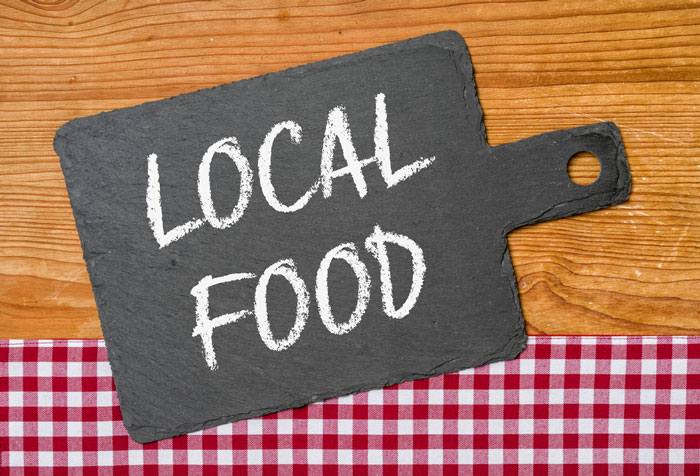The perks of buying local
- Like
- Digg
- Del
- Tumblr
- VKontakte
- Buffer
- Love This
- Odnoklassniki
- Meneame
- Blogger
- Amazon
- Yahoo Mail
- Gmail
- AOL
- Newsvine
- HackerNews
- Evernote
- MySpace
- Mail.ru
- Viadeo
- Line
- Comments
- Yummly
- SMS
- Viber
- Telegram
- Subscribe
- Skype
- Facebook Messenger
- Kakao
- LiveJournal
- Yammer
- Edgar
- Fintel
- Mix
- Instapaper
- Copy Link
Posted: 1 November 2017 | Allison Stowell | Dietitian | Guiding Stars, Kitty Broihier | Scientific Advisor | Guiding Stars, Megan Majeski | Global Sustainability Graduate | Guiding Stars | No comments yet
A general consensus agrees that food less than 400 miles from its origin, or within state boundaries, qualifies as locally grown. Allison Stowell, Megan Majeski and Kitty Broihier, explain why buying local produce is good for you, the environment and the economy.


BUY LOCAL: Seasonal eating allows us to build meals around freshly harvested foods at their peak and adapt our diet to welcome the varying crops of the season.
The idea of eating locally-sourced foods is not exactly new, after all, local agriculture was once the only way to eat. Today, however, the increasing presence of local options in supermarkets is relatively new. Because there is no predetermined distance to define what consumers consider ‘local’, the US Department of Agriculture defines local food as, “the direct or intermediated marketing of food to consumers that is produced and distributed in a limited geographic area.” A general consensus agrees that food less than 400 miles from its origin, or within state boundaries, qualifies as locally grown.
Seasonal eating allows us to build meals around freshly harvested foods at their peak and adapt our diet to welcome the varying crops of the season. Eating seasonally puts us in touch with the natural rhythms of the land around us and allows us to appreciate the unique bounty each season has to offer. Additionally, farmers growing food for local consumption have the luxury of being able to choose varieties of produce based on taste and nutrition, versus yield or ability to endure transport. That also means heirloom varieties of your favourites are more likely to be available locally.
Many communities offer various programmes to help support local food systems.
Aside from the cost you see on the shifting price tag of produce, which may be the only hint we have that something is in season, local farmers markets are a boon to seasonal eaters because they provide mainly seasonal products. Seasonal eating brings variety into your diet, which can improve health by providing a more diverse array of vitamins and minerals. What’s more, food in season is at its peak nutritionally, and the shorter storage and transport factors mean more of these nutrients are maintained in seasonal, local produce.
Community
There is something very satisfying about knowing the farmer who grew the product you are buying. Personal connection is something we seem to have less and less of in our society, so buying local products and eating locally is a nice way to keep your community strong and make your world a little more personal. When we support our community farmers, we are also helping our local economy flourish.
Locally grown agriculture travels shorter distances, allowing maximum nutritional density
Small farms are found throughout the United States, many of which have thrived for generations. Yet, just a few, much larger farms are providing the majority of our food. According to the USDA, both the number and development of small farms have declined. In order for small farms to be sustained, we need to view the farm as a whole and understand the importance of community ties. Eating locally supports the growth of community.
Sustainable food systems
Food systems describe the manner in which food is grown or raised, harvested, and processed. Local food systems are typically more reliant on sustainable agriculture, which recognises the importance of using the land responsibly and preserving natural resources for future use while maintaining an ecological balance. This translates into the highest quality farm products with the lowest negative impact on the planet. By buying local, you can support sustainable practices to ensure the longevity of healthy foods for future generations.
Many communities offer various programmes to help support local food systems, for example purchasing food directly from farmers through community supported agriculture (CSA) schemes. Such programs offer subscribers shares in the farm’s bounty throughout the growing season, usually in the form of weekly produce boxes. Farmers markets are another way to purchase locally grown products. The USDA has provided a Local Food Directory to simplify your search. Additionally, grocery stores have been increasing offerings of locally grown products; look for signs highlighting local farms or inquire at the customer service desk. Buying from local farms ensures the future of sustainable food systems.
Nutrition
Large-scale agricultural standards require produce to be bred for high yield, fast growth rate and ability to withstand long distance transport. The result is low-cost, hardy produce. However, research illustrates that higher yielding varieties may also have lower nutrient profiles. Long-distance transportation from larger farms requires harvesting prior to being ripe to reduce damage and spoilage. On the other hand, local produce can remain on the plant to ripen naturally. Because ripened produce is more susceptible to bruising and has a shorter post-harvest life, local farmers sell their produce in markets within a day or two of being picked.
Locally grown agriculture travels shorter distances, allowing maximum nutritional density. The longer produce is stored, the more nutrients it will lose in general. It just stands to reason that old, limp, dehydrated vegetables won’t have as many nutrients as freshly harvested vegetables will. A literary review conducted by Diane M. Barrett examined various research studies on the nutritional value of produce. Barrett concluded vitamin loss can occur with long distance transportation and storage of fruits and vegetables. Getting your groceries locally is a great way to get top quality produce, and eating locally is far more cost efficient where nutrients are concerned.
Economic
Money spent locally fuels new employment and job opportunities for people within the community, which in turn helps create a more stable, recession-resistant local economy and community alike. Local purchasing helps keep money circulating within the local economy, supporting everyone. Economic studies report local business owners recirculate a greater share of every dollar, compared to national chain retailers, which can mean more money in your own pocket.
Environmental
When your local growing season ends, that produce may have far to travel in order to arrive on your store shelves, which means much more fuel used and a greater number of trucks on our roads. According to the EPA, transportation is the second leading source of greenhouse gas emissions in the United States, with about 9 per cent of that transportation attributed to agriculture. While you may choose to buy organic produce because you believe it’s better for the environment, if it’s sourced from across the country, you may be doing more harm than good. Locally grown agriculture travels a much shorter distance from farm to table. Eating local helps decrease food miles as well as lowers your personal carbon footprint.
Additionally, industrial agriculture usually doesn’t allow for proper crop rotation, rather, they produce mono crops, creating the need for mass amounts of synthetic fertilisers to be added to soil each year. The excessive fertiliser often runs off into nearby water systems, disrupting various ecosystems and polluting natural habitats. Local, smaller farms can rotate crops, avoiding the pitfalls of mono cropping, enhancing the health of soil through natural nutrient enrichment.
There are numerous perks associated with buying and eating locally. Whether you’re looking for healthy dietary changes from eating seasonally, desire a personal relationship with your local farmer, or just want to lower your impact on the environment, buying local is a smart option. While ‘local’ is no longer our only option, we can choose to reap the benefits of going back to our roots.
Issue
Related topics
Health & Nutrition, Natural, Sustainability, Trade & Economy








